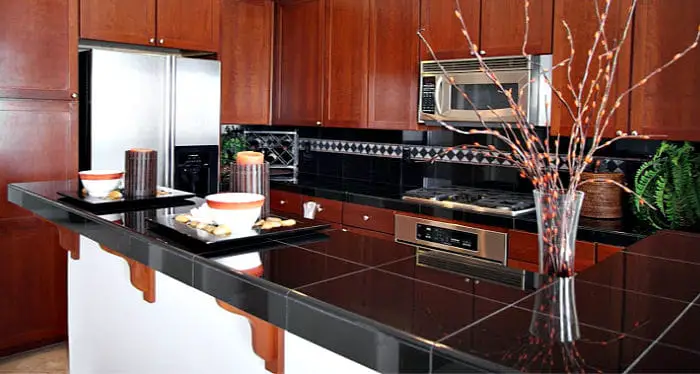Granite Tile Countertop vs. Slab
What's The Difference?
A granite tile countertop is an excellent option for those who desire the look, lasting value and superior durability of granite, but at a cost savings of up to 50% - 75% compared to a full-slab granite countertop installation.
Of course, there's a reason for the big price difference, but also cleaning and design considerations for a kitchen granite tile countertop... so let's review the pros and cons...
Granite is an igneous rock formed over millions of years from hot liquid magma and composed of various minerals such as quartz, feldspar and mica.
The particular mix of minerals create the unique colors, textures and pattern movement found in all the different varieties of granite... over 2700 varieties and counting.
 Black Granite Tile Countertops
Black Granite Tile CountertopsGranite is nearly as hard as diamonds, which is why granite is considered the most durable, heat and stain resistant countertop material available.
Engineered quartz countertops are a close second, but hot pans can damage the resin used to make quartz countertops.
Granite is also the most hygienic (tied with quartz) surface and highly resistant to bacteria.
Granite Tile Countertop vs. Slab
Now of course, you get essentially the same qualities and characteristics of granite whether installing granite tile or a full-slab bathroom or kitchen countertop, so lets look at the differences, advantages, and disadvantages of granite tile vs granite slab.
Granite Tile Countertop Cost
Generally a granite tile countertop will cost 50% to 75% less than a full-slab.
For a full-slab you’ll typically pay between $40 and $125 per square foot (Beware of the very low end quotes). Most commonly, though, you'll pay $55 - $65 sq. ft.
- Expect to pay about $10 to $30 per square foot when installing a granite tile countertop.
And sometimes, in some areas, and with very cheap granite tile the cost can go as low as $7 sq. ft. saving you a bunch.
Of all the kitchen countertop materials available, granite tile is among the cheapest yet most durable.
This above is also true when installing outdoor kitchen countertop tile.
But... a tile countertop is significantly different than a full slab granite countertop.
The big difference here is in the volume of stone and the cost of fabrication. Granite tiles are much thinner than a slab, so less stone is consumed for the same surface area.
Also, the skill and tools required to work with a slab of granite are more sophisticated and specialized than those required installing tile. In fact, a competent do-it-yourselfer with tile experience can install a granite tile countertop.
Grouting a Granite Tile Countertop
Of course, it is necessary to use grout between the tiles when installing a granite tile countertop.
Non-sanded grout is what you'll want to use for polished granite with narrow grout lines. And generally, you want narrow grout lines and as little grout as possible on a kitchen tile countertop.
Narrow grout lines also help to achieve a more seamless look like a granite slab.
On a full-slab you may have a seam or two, but no grout except for the grout or caulking between the granite countertop and backsplash.
Be sure to use 100% silicone caulk for the seam between the backsplash and countertop.
Grout presents unique challenges mainly regarding granite countertop care and maintenance. Grout easily attracts dirt and grime, is porous, can crack and break down when absorbing excess moisture.
The grout must be sealed, cleaned and maintained more particularly than the granite tiles.
Sealing & Cleaning Granite Tile
In general, it is recommended to apply a granite sealer to retard staining.
However, several granite varieties (darker granite colors like black granite tile, blue, green) are so dense and stain-proof that they don’t need sealing, in fact, will not absorb a sealant.
But even for those varieties that do need sealing, it’s not a complicated job.
When using a quality stone sealer and it doesn’t need to be done more than every 3-5 years and often much longer.
The good news is that grout lines are very narrow with granite tile and you can use the same impregnating sealer to seal the tiles and the grout. Typically, once the grout is well sealed, it’s not much of a problem.
It will still require more attention than the tiles or a slab countertop, but with normal cleaning, care and maintenance it will look great for a long time without much extra hassle.
For cleaning granite... this Granite & Marble Cleaner is very popular and dries streak-free. Or you may prefer the more environmentally-friendly Green Granite & Marble Cleaner.
To shine granite... use the Topical Granite & Marble Polish to make the color and shine really pop!
Granite Tile Countertop Edges & Design
Edge styles are definitely much more limited with a granite tile countertop vs. a granite slab... that is if you want the edge to also the same granite tile.
For a granite slab countertop edges many styles are possible such as ogee, bullnose, French cove, or dupont.
However, for a granite tile countertop edge your only real option is a mitered square edge that will have a grout seam right at the corner.
It is possible to slightly round off the corner by grinding or shaping the edges of the tiles that create the edge corner seam. This rounded or "eased" edge can be a bit more aesthetically pleasing and can help to prevent chipping.
You could also do a bevel edge (as seen in the photo above) but that is just adding one more grout seam (weaker than the granite) to an area that gets a lot of use and contact.
Plus it's one more grout seam to get dirty and keep clean.
A simple square edge is the best choice unless you can find a pre-made edge tile for your granite color (see other options below).
However, you can create that thick edge look of a 3 cm slab countertop since you can make the vertical edge tile any size you like. It could be 2 cm (3/4") or 3 cm (1 1/4") or even 10 cm (4") so long as it doesn't impede opening drawers or cabinets doors.
Other granite tile countertop edge options:
- Pre-shaped granite edge tile. Depending on the color of your granite tile you might find specific "edge tiles" to match. Most commonly this is a half-round piece that fits on the edge corner eliminating the vulnerable grout seam on the corner. Fancy shapes may be available too but usually these come with a complete modular granite countertop kit.
- Decorative tile (painted, glass, mosaic, or with a different color or pattern) will add a surprising and unique design element. Or use the same tile as used on the backsplash (if using a different tile than for the countertop).
- A wood edge strip could be charming and in the right kitchen design.
- Stainless steel or another metal would be cool in an industrial design.
Backsplash Design for Granite Tile Countertops
With a full-slab countertop you can create almost any backsplash design that works with the colors of your granite. However, with a granite tile countertop you have grout lines as an added design element.
This may limit what you do for a backsplash, especially if you are considering using a different tile and particularly a different size of tile.... the grout lines start to clash.
Most often you'll use a 12x12 inch granite tile for a countertop. The dimensions work best. Now, using that same tile as a backsplash will look fabulous and is probably the best option for over-all design continuity and visual impact.
And you can still spice it up with some smaller detail pieces (1x1 or 2x2 tiles of different color/texture/material) in the center of the backsplash where grout lines cross at the larger granite tile corners.
Granite Tile vs. Other Countertop Tiles
Granite also wins out when compared to other tiles for overall durability and lasting value.
Porcelain tile is becoming popular and is more sturdy than ceramic with lots of color choices, but does not provide the same look or durability as granite.
Porcelain tile is highly stain-resistant and does not need sealing (in most cases) but the grout still does. Porcelain will chip and crack more easily than granite tile. And the color is not full-thickness so repairs will always be visible.
Marble or travertine is sometimes considered, but these stones are not a good choice for the kitchen as they will etch or corrode upon contact with acidic foods. Fine for a bathroom countertop though.
Is granite tile good for kitchen countertops?
If you love the look and performance advantage of granite, don’t mind the extra grout maintenance, and want to save some big bucks, then yes... a granite tile countertop is a perfect choice for a bathroom or kitchen countertop.


